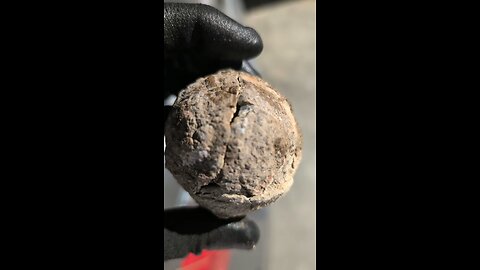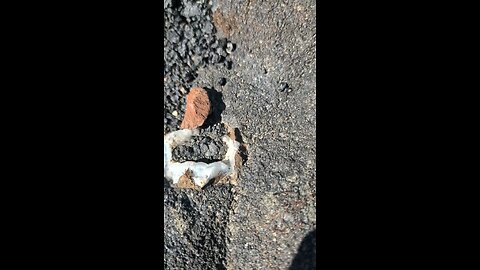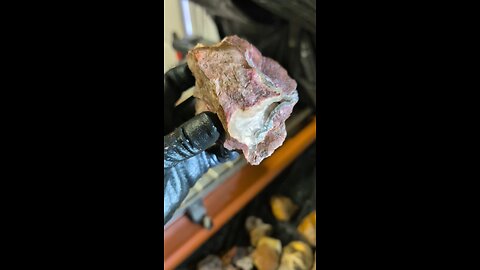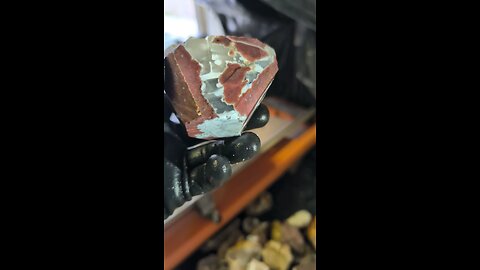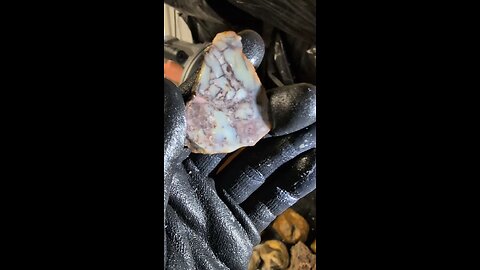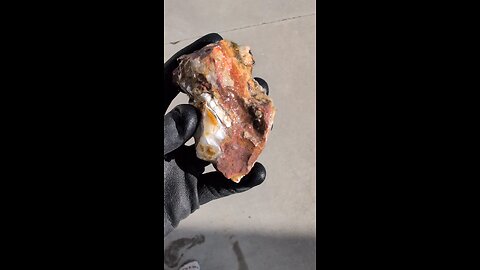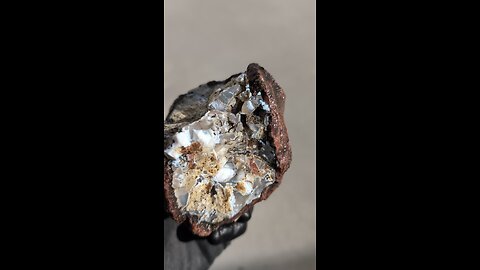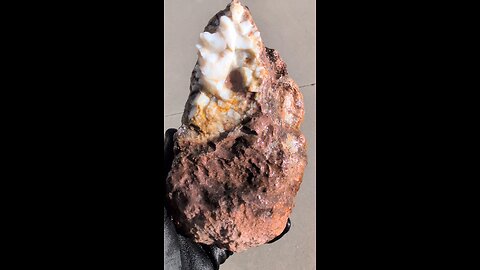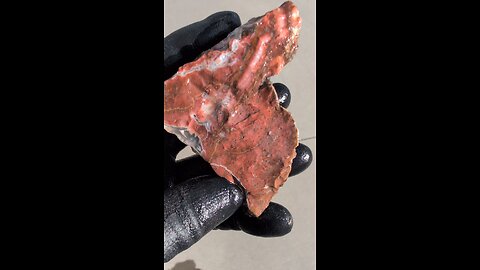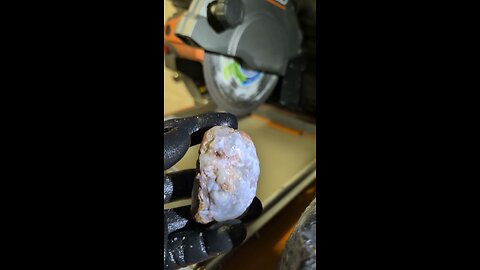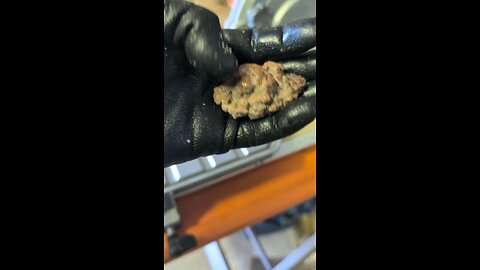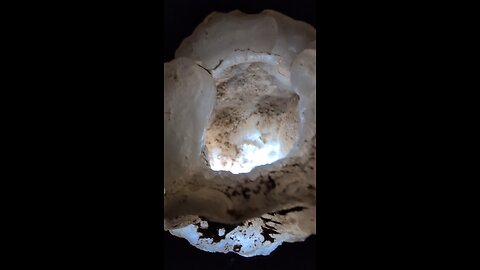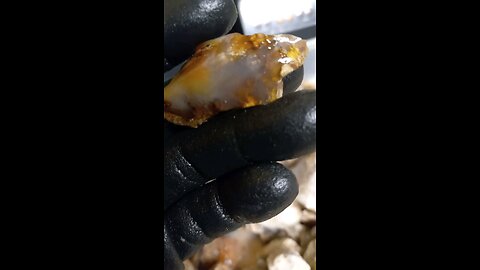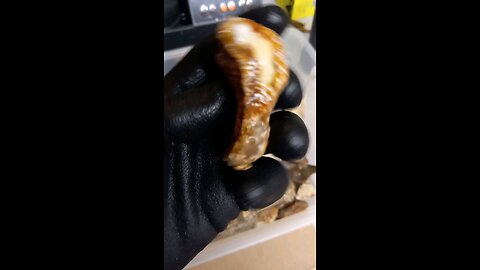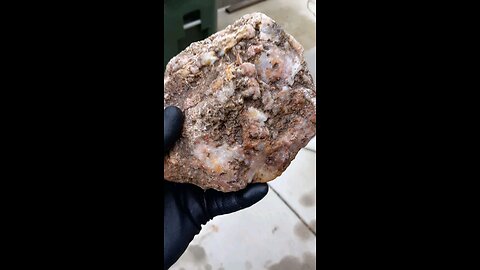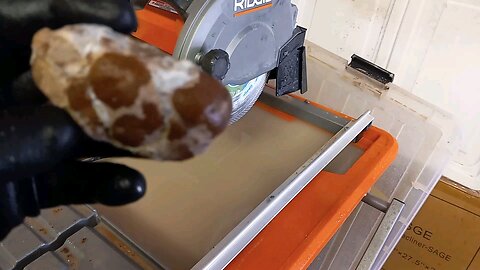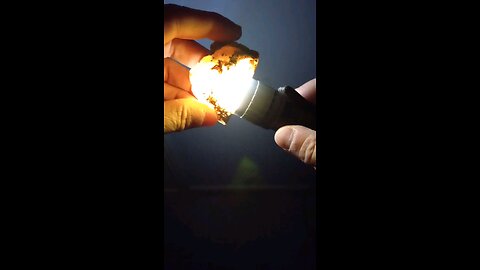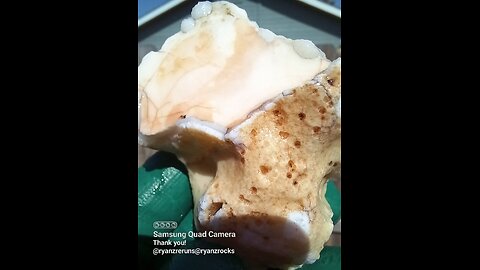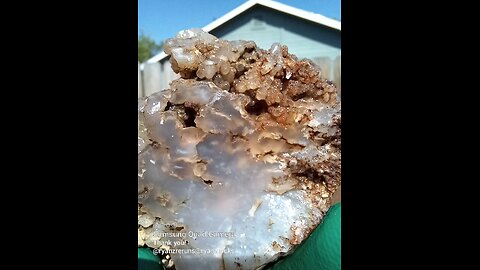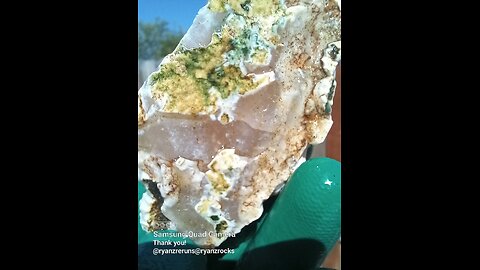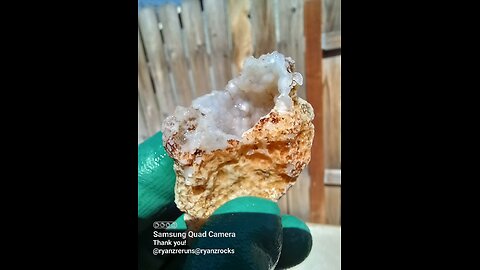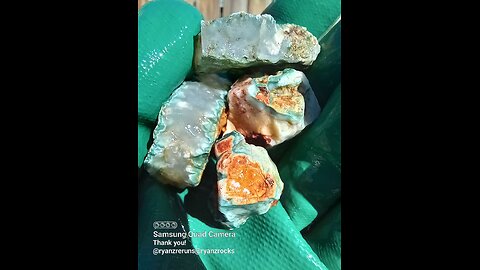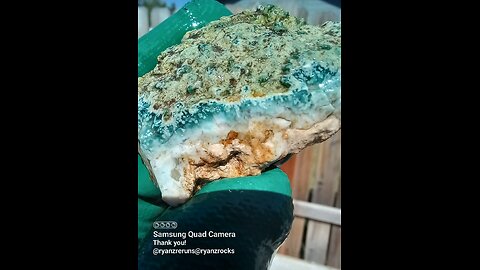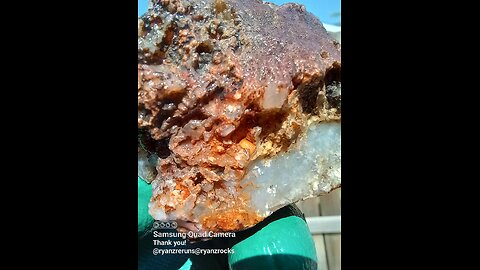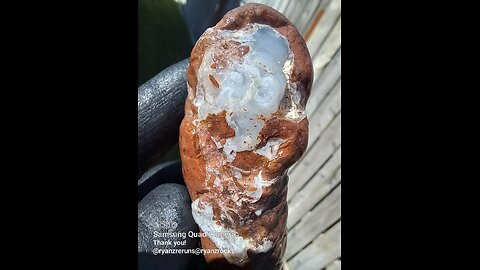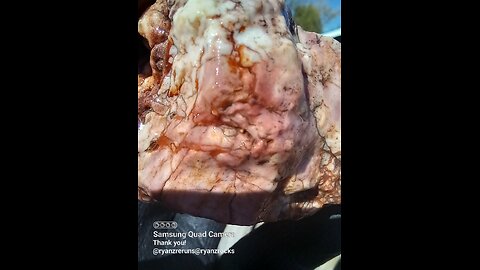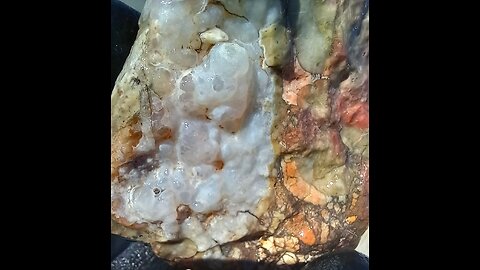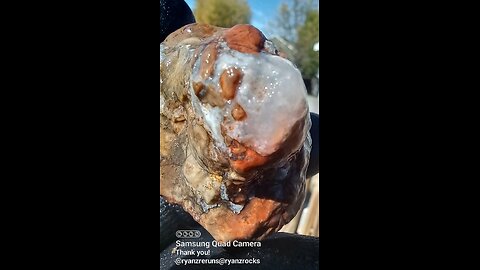Premium Only Content
This video is only available to Rumble Premium subscribers. Subscribe to
enjoy exclusive content and ad-free viewing.

Opal!
HumbleConservative
- 29 / 42
1
Whole & Broken Geodes!
HumbleConservative
A geode is a hollow, usually spherical rock, that when broken open reveals a cavity lined with crystals or other mineral formations. Here are some key points about geodes:
Formation: Geodes form when gas bubbles or cavities in volcanic or sedimentary rock are filled with mineral-rich water. As the water evaporates, it leaves behind minerals which crystallize over time, lining the inside of the cavity.
Structure: The outer layer of a geode is typically rough and nondescript, often making it look like an ordinary rock until it's cracked open. Inside, you might find crystals like quartz, amethyst, calcite, or even rarer minerals.
Location: They are commonly found in regions with volcanic activity or limestone deposits. Famous locations include parts of the United States, Brazil, Uruguay, and Mexico.
Uses: Geodes are popular among rock collectors and are often cut and polished for use in jewelry or as decorative pieces. Some are also used in metaphysical practices for their supposed healing properties.
Identification: To identify a geode, one would typically look for a rock that is unusually light for its size or has a hollow sound when tapped. However, the only definitive way to confirm is by breaking it open or using specialized equipment like X-rays.
If you're interested in finding or identifying geodes, or if you have any other questions about them, feel free to ask!Rabbit Springs Geode Field, is a well-known rockhounding site located in southern Idaho near the Nevada border. It’s a popular spot for collectors seeking thundereggs—spherical rocks that often contain beautiful agate or crystal-filled centers, some of which fluoresce under UV light due to mineral content like chalcedony or quartz.
2
Geode Field!
HumbleConservative
Rabbit Springs Geode Field, also known as Rabbit Springs Thundereggs, is a well-known rockhounding site located in southern Idaho near the Nevada border. It’s a popular spot for collectors seeking thundereggs—spherical rocks that often contain beautiful agate or crystal-filled centers, some of which fluoresce under UV light due to mineral content like chalcedony or quartz. This site sits along U.S. Highway 93, roughly 38 miles from Twin Falls, Idaho, and about 130 miles from Mountain Home, making it accessible yet remote enough to feel like a true adventure.
The coordinates for Rabbit Springs are approximately 42.06572°N, -114.67387°W. You can get there by driving south from Twin Falls toward Jackpot, Nevada, and looking for the old Rabbit Springs rest area, a historical marker for the site. The terrain is rugged, typical of the high desert landscape in this region, with volcanic and sedimentary rocks from ancient geological activity providing the perfect conditions for thunderegg formation. These rocks are remnants of gas pockets in lava flows that filled with silica-rich fluids over millions of years.
No heavy digging is necessary here—surface collecting with a bucket is the way to go, as many thundereggs are weathered out and scattered across the ground. A rock hammer might come in handy to crack them open, but locals and seasoned rockhounds suggest the best finds are often already exposed, and breaking into the bedrock isn’t worth the effort. The thundereggs vary in size, from plums to grapefruits, and some glow a striking green or orange under a 365nm UV light, thanks to trace minerals. Rumors of radioactivity have floated around, but tests with Geiger counters have debunked that myth.
The site is on public land managed by the Bureau of Land Management (BLM), so casual collecting is allowed as long as you’re not using heavy machinery or digging extensive tunnels—stick to hand tools and surface finds. Any vehicle can make the trip, though the final approach might involve a short walk from the highway. September’s cooler weather makes it an ideal time to visit, avoiding the summer heat of this arid region.
3
Botryoidal cut!
HumbleConservative
Botryoidal is a term used in mineralogy to describe a mineral or rock formation that has a rounded, grape-like, or botryoidal (from the Greek word "botryoeidēs" meaning "like a bunch of grapes") shape. Here are some key points about botryoidal formations:
Formation: Botryoidal structures form when minerals precipitate from solution in a way that creates rounded, nodular surfaces. This often happens in cavities or vugs within rocks where mineral-rich solutions slowly deposit layers of minerals, building up in a manner that mimics the shape of grapes.
Common Minerals: Some minerals commonly found in botryoidal forms include:
Hematite: Often forms botryoidal shapes with a metallic luster.
Malachite: Known for its vibrant green botryoidal formations.
Goethite: Can exhibit botryoidal textures, usually in brown or yellow hues.
Chalcedony: Including varieties like agate, which can form botryoidal layers within geodes.
Psilomelane: A manganese oxide mineral often found in botryoidal shapes.
Texture: The texture of botryoidal minerals is smooth and rounded, with a surface that looks like clusters of small spheres or nodules. This texture is due to the slow, even deposition of mineral material from solution.
Uses:
Jewelry and Decoration: Botryoidal minerals are prized for their unique shapes and are often polished or cut into cabochons for use in jewelry. They can also be used as decorative stones.
Collectors: Due to their distinctive appearance, botryoidal specimens are popular among mineral collectors.
Art: Their natural beauty makes them suitable for artistic endeavors, including sculptures or inlays.
Geological Significance: Botryoidal formations can provide insights into the conditions under which the minerals precipitated, often indicating slow, stable conditions conducive to this type of growth. They are also indicators of the fluid dynamics and chemistry in the environment where they formed.
4
Shaping!
HumbleConservative
A Thunderegg is a geological structure similar to a geode but with unique characteristics. Here's an overview:
Formation: Thundereggs form within rhyolitic volcanic ash layers. They start as gas bubbles or steam pockets in the lava, which act as molds. Over time, these are filled with silica-rich fluids, mainly chalcedony, agate, jasper, or opal, creating intricate patterns and colors inside.
Appearance: On the outside, thundereggs look like ordinary, rough-textured rocks, often with a white-gray to reddish-brown surface. However, when cut and polished, they reveal a variety of internal structures, from solid agate or chalcedony cores to sometimes hollow centers with crystals.
Size: They can range from small, about the size of a baseball, to larger specimens over a meter across, though most commonly they are between two to six inches in diameter.
Locations: While Oregon, USA, is particularly famous for thundereggs, especially in counties like Crook, Jefferson, Malheur, Wasco, and Wheeler, they are found globally wherever the geological conditions are right. Other notable locations include Germany, Australia, Brazil, Canada, Mexico, Poland, Romania, and Turkey.
Cultural Significance: In Oregon, the thunderegg was designated as the state rock in 1965, reflecting its importance in local geology and culture. Native American legends attribute their formation to thunder spirits or gods throwing these rocks during thunderstorms.
Collection and Use: Thundereggs are popular among rock collectors for their unique beauty once cut open. They're often used in jewelry making or as display pieces due to their aesthetic appeal after being sliced and polished.
Variations: Each thunderegg is unique due to the minerals present in the area where it forms, leading to a wide variety in color, pattern, and structure even from the same bed.
5
Opalized wood!
HumbleConservative
This rock looks like opalized wood or opalized petrified wood.
Here's why:
* Wood Grain Texture: You can see the distinct grain and texture of wood, indicating it was once a piece of a tree or branch.
* Opal-like Sheen/Color: The light blue, almost milky appearance with hints of other colors (like the brown you see in the center) is characteristic of opal. Opal is a mineraloid that often replaces organic materials, including wood.
* Fracturing: The way the surface is cracked or shows a "crazed" pattern is also common in opal, as it can be somewhat brittle.
Opalized wood forms when silica-rich solutions infiltrate wood and replace the organic material with opal, preserving the wood's form. The presence of opal gives it a unique look compared to other types of petrified wood.
6
Broken Thunderegg Cluster!
HumbleConservative
A Thunderegg is a geological structure similar to a geode but with unique characteristics. Here's an overview:
Formation: Thundereggs form within rhyolitic volcanic ash layers. They start as gas bubbles or steam pockets in the lava, which act as molds. Over time, these are filled with silica-rich fluids, mainly chalcedony, agate, jasper, or opal, creating intricate patterns and colors inside.
Appearance: On the outside, thundereggs look like ordinary, rough-textured rocks, often with a white-gray to reddish-brown surface. However, when cut and polished, they reveal a variety of internal structures, from solid agate or chalcedony cores to sometimes hollow centers with crystals.
Size: They can range from small, about the size of a baseball, to larger specimens over a meter across, though most commonly they are between two to six inches in diameter.
Locations: While Oregon, USA, is particularly famous for thundereggs, especially in counties like Crook, Jefferson, Malheur, Wasco, and Wheeler, they are found globally wherever the geological conditions are right. Other notable locations include Germany, Australia, Brazil, Canada, Mexico, Poland, Romania, and Turkey.
Cultural Significance: In Oregon, the thunderegg was designated as the state rock in 1965, reflecting its importance in local geology and culture. Native American legends attribute their formation to thunder spirits or gods throwing these rocks during thunderstorms.
Collection and Use: Thundereggs are popular among rock collectors for their unique beauty once cut open. They're often used in jewelry making or as display pieces due to their aesthetic appeal after being sliced and polished.
Variations: Each thunderegg is unique due to the minerals present in the area where it forms, leading to a wide variety in color, pattern, and structure even from the same bed.
7
Half a thunderegg!
HumbleConservative
A Thunderegg is a geological structure similar to a geode but with unique characteristics. Here's an overview:
Formation: Thundereggs form within rhyolitic volcanic ash layers. They start as gas bubbles or steam pockets in the lava, which act as molds. Over time, these are filled with silica-rich fluids, mainly chalcedony, agate, jasper, or opal, creating intricate patterns and colors inside.
Appearance: On the outside, thundereggs look like ordinary, rough-textured rocks, often with a white-gray to reddish-brown surface. However, when cut and polished, they reveal a variety of internal structures, from solid agate or chalcedony cores to sometimes hollow centers with crystals.
Size: They can range from small, about the size of a baseball, to larger specimens over a meter across, though most commonly they are between two to six inches in diameter.
Locations: While Oregon, USA, is particularly famous for thundereggs, especially in counties like Crook, Jefferson, Malheur, Wasco, and Wheeler, they are found globally wherever the geological conditions are right. Other notable locations include Germany, Australia, Brazil, Canada, Mexico, Poland, Romania, and Turkey.
Cultural Significance: In Oregon, the thunderegg was designated as the state rock in 1965, reflecting its importance in local geology and culture. Native American legends attribute their formation to thunder spirits or gods throwing these rocks during thunderstorms.
Collection and Use: Thundereggs are popular among rock collectors for their unique beauty once cut open. They're often used in jewelry making or as display pieces due to their aesthetic appeal after being sliced and polished.
Variations: Each thunderegg is unique due to the minerals present in the area where it forms, leading to a wide variety in color, pattern, and structure even from the same bed.
8
Thunderegg Cluster w Common Opal!
HumbleConservative
A Thunderegg is a geological structure similar to a geode but with unique characteristics. Here's an overview:
Formation: Thundereggs form within rhyolitic volcanic ash layers. They start as gas bubbles or steam pockets in the lava, which act as molds. Over time, these are filled with silica-rich fluids, mainly chalcedony, agate, jasper, or opal, creating intricate patterns and colors inside.
Appearance: On the outside, thundereggs look like ordinary, rough-textured rocks, often with a white-gray to reddish-brown surface. However, when cut and polished, they reveal a variety of internal structures, from solid agate or chalcedony cores to sometimes hollow centers with crystals.
Size: They can range from small, about the size of a baseball, to larger specimens over a meter across, though most commonly they are between two to six inches in diameter.
Locations: While Oregon, USA, is particularly famous for thundereggs, especially in counties like Crook, Jefferson, Malheur, Wasco, and Wheeler, they are found globally wherever the geological conditions are right. Other notable locations include Germany, Australia, Brazil, Canada, Mexico, Poland, Romania, and Turkey.
Cultural Significance: In Oregon, the thunderegg was designated as the state rock in 1965, reflecting its importance in local geology and culture. Native American legends attribute their formation to thunder spirits or gods throwing these rocks during thunderstorms.
Collection and Use: Thundereggs are popular among rock collectors for their unique beauty once cut open. They're often used in jewelry making or as display pieces due to their aesthetic appeal after being sliced and polished.
Variations: Each thunderegg is unique due to the minerals present in the area where it forms, leading to a wide variety in color, pattern, and structure even from the same bed.
9
Red Thunderegg Shard!
HumbleConservative
A Thunderegg is a geological structure similar to a geode but with unique characteristics. Here's an overview:
Formation: Thundereggs form within rhyolitic volcanic ash layers. They start as gas bubbles or steam pockets in the lava, which act as molds. Over time, these are filled with silica-rich fluids, mainly chalcedony, agate, jasper, or opal, creating intricate patterns and colors inside.
Appearance: On the outside, thundereggs look like ordinary, rough-textured rocks, often with a white-gray to reddish-brown surface. However, when cut and polished, they reveal a variety of internal structures, from solid agate or chalcedony cores to sometimes hollow centers with crystals.
Size: They can range from small, about the size of a baseball, to larger specimens over a meter across, though most commonly they are between two to six inches in diameter.
Locations: While Oregon, USA, is particularly famous for thundereggs, especially in counties like Crook, Jefferson, Malheur, Wasco, and Wheeler, they are found globally wherever the geological conditions are right. Other notable locations include Germany, Australia, Brazil, Canada, Mexico, Poland, Romania, and Turkey.
Cultural Significance: In Oregon, the thunderegg was designated as the state rock in 1965, reflecting its importance in local geology and culture. Native American legends attribute their formation to thunder spirits or gods throwing these rocks during thunderstorms.
Collection and Use: Thundereggs are popular among rock collectors for their unique beauty once cut open. They're often used in jewelry making or as display pieces due to their aesthetic appeal after being sliced and polished.
Variations: Each thunderegg is unique due to the minerals present in the area where it forms, leading to a wide variety in color, pattern, and structure even from the same bed.
10
Robbed! Grabbed the wrong half!
HumbleConservative
This rock appears to be a type of **thunder egg**. Here's why:
1. **Coloration and Banding**: The rock shows a combination of colors, including brown, white, green, and possibly some hints of other colors, which is typical for agates and thunder eggs. The banding pattern is also characteristic of agates, which form in cavities of volcanic rocks.
2. **Translucency**: Some parts of the rock are translucent, which is common in agates due to their chalcedony composition.
3. **Texture**: The rock's texture looks somewhat waxy or glassy, which is typical for agates that have been polished or naturally worn smooth.
4. **Inclusions**: The yellowish or brownish areas could be due to iron oxide or other mineral inclusions, which are often found in agates. Thunder eggs are nodules of agate found in volcanic rocks, and they often have a hollow or partially hollow interior filled with crystals or banded agate.
11
Thunderegg Cut w/Opal!
HumbleConservative
These rocks appears to be a type of **thunder egg**. Here's why:
1. **Coloration and Banding**: The rock shows a combination of colors, including brown, white, green, and possibly some hints of other colors, which is typical for agates and thunder eggs. The banding pattern is also characteristic of agates, which form in cavities of volcanic rocks.
2. **Translucency**: Some parts of the rock are translucent, which is common in agates due to their chalcedony composition.
3. **Texture**: The rock's texture looks somewhat waxy or glassy, which is typical for agates that have been polished or naturally worn smooth.
4. **Inclusions**: The yellowish or brownish areas could be due to iron oxide or other mineral inclusions, which are often found in agates. Thunder eggs are nodules of agate found in volcanic rocks, and they often have a hollow or partially hollow interior filled with crystals or banded agate.
12
Thundereggs?
HumbleConservative
These rocks appears to be a type of **thunder egg**. Here's why:
1. **Coloration and Banding**: The rock shows a combination of colors, including brown, white, green, and possibly some hints of other colors, which is typical for agates and thunder eggs. The banding pattern is also characteristic of agates, which form in cavities of volcanic rocks.
2. **Translucency**: Some parts of the rock are translucent, which is common in agates due to their chalcedony composition.
3. **Texture**: The rock's texture looks somewhat waxy or glassy, which is typical for agates that have been polished or naturally worn smooth.
4. **Inclusions**: The yellowish or brownish areas could be due to iron oxide or other mineral inclusions, which are often found in agates. Thunder eggs are nodules of agate found in volcanic rocks, and they often have a hollow or partially hollow interior filled with crystals or banded agate.
13
Thundercup glow!
HumbleConservative
These rocks appears to be a type of **thunder egg**. Here's why:
1. **Coloration and Banding**: The rock shows a combination of colors, including brown, white, green, and possibly some hints of other colors, which is typical for agates and thunder eggs. The banding pattern is also characteristic of agates, which form in cavities of volcanic rocks.
2. **Translucency**: Some parts of the rock are translucent, which is common in agates due to their chalcedony composition.
3. **Texture**: The rock's texture looks somewhat waxy or glassy, which is typical for agates that have been polished or naturally worn smooth.
4. **Inclusions**: The yellowish or brownish areas could be due to iron oxide or other mineral inclusions, which are often found in agates. Thunder eggs are nodules of agate found in volcanic rocks, and they often have a hollow or partially hollow interior filled with crystals or banded agate.
14
Thunderegg glow!
HumbleConservative
These rocks appears to be a type of **thunder egg**. Here's why:
1. **Coloration and Banding**: The rock shows a combination of colors, including brown, white, green, and possibly some hints of other colors, which is typical for agates and thunder eggs. The banding pattern is also characteristic of agates, which form in cavities of volcanic rocks.
2. **Translucency**: Some parts of the rock are translucent, which is common in agates due to their chalcedony composition.
3. **Texture**: The rock's texture looks somewhat waxy or glassy, which is typical for agates that have been polished or naturally worn smooth.
4. **Inclusions**: The yellowish or brownish areas could be due to iron oxide or other mineral inclusions, which are often found in agates. Thunder eggs are nodules of agate found in volcanic rocks, and they often have a hollow or partially hollow interior filled with crystals or banded agate.
1
comment
15
Beautiful dark opal!
HumbleConservative
Opal is a hydrated amorphous form of silica, with a water content typically between 3 and 21% by weight, most commonly around 6-10%. It's deposited at relatively low temperatures and can be found in the fissures of various rock types, including limonite, sandstone, rhyolite, marl, and basalt. Here's a deeper look into opal:
Types of Opal:
Precious Opal: Known for its "play-of-color," which is an optical phenomenon where colors flash or change as the angle of light or observation changes. This effect is due to the diffraction of light through the microscopic silica spheres within the opal.
Common Opal: Lacks the play-of-color and can come in a variety of colors like white, black, grey, yellow, orange, red, or brown. It's often referred to as "potch" when not gem-quality.
Fire Opal: Typically ranges in color from yellow to orange to red and can be transparent to translucent. Fire opals can exhibit play-of-color, but their name comes from the fiery body color.
Boulder Opal: A type of opal naturally attached to its host rock. It's often cut with the host rock to provide stability and to enhance the visual appeal.
Matrix Opal: The opal fills the cracks and cavities within the host rock, creating a network of opal that's visible on the surface.
Formation:
Primary Opal: Forms through the slow deposition of silica from groundwater in cavities or fractures of rocks.
Secondary Opal: Can form by weathering or alteration of other minerals, often in more superficial environments or through the action of silica-rich waters.
Locations:
Australia: The world's leading source, especially for precious opal, with significant deposits in places like Coober Pedy, Lightning Ridge, and White Cliffs.
Ethiopia: Known for its black opals and more recently discovered opal fields.
Mexico: Famous for fire opals.
Brazil: Produces a variety of opals, including crystal opal.
Properties:
Hardness: Typically ranges between 5.5 to 6.5 on the Mohs scale, though it can be softer if less hydrated or harder if more silica-rich.
Luster: Can range from waxy to resinous to vitreous.
Transparency: Varies from opaque to semi-translucent to transparent.
16
It's curved!
HumbleConservative
Plume agate is a variety of chalcedony, a microcrystalline quartz, characterized by delicate, plume-like inclusions of various colors and minerals. These inclusions often resemble feathers, flowers, or flames, giving the agate a unique and visually appealing appearance.
Plume agate only forms in hotsprings with the help of thermophiles and extremophiles (microscopic organisms that like harsh and hot environments) collecting silica and other dissolved particles in silica rich hotsprings and depositing them in wild patterns within the agate.
A combination of clays, metals and minerals make up the cool colors and textures we experience.
There are many famous deposits of plume, flame and other varieties of textures made with the assistance of microbes.
17
Botryoidal formations!
HumbleConservative
Plume agate is a variety of chalcedony, a microcrystalline quartz, characterized by delicate, plume-like inclusions of various colors and minerals. These inclusions often resemble feathers, flowers, or flames, giving the agate a unique and visually appealing appearance.
Plume agate only forms in hotsprings with the help of thermophiles and extremophiles (microscopic organisms that like harsh and hot environments) collecting silica and other dissolved particles in silica rich hotsprings and depositing them in wild patterns within the agate.
A combination of clays, metals and minerals make up the cool colors and textures we experience.
There are many famous deposits of plume, flame and other varieties of textures made with the assistance of microbes.
18
Jasper, Chalcedony, Opal & ???
HumbleConservative
This rock has characteristics that suggest it could be a type of brecciated jasper or agate. Here are the reasons for this identification:
Texture and Appearance: The rock has a mix of colors, predominantly white with patches of brown, red, and possibly some darker inclusions. This mottled appearance with different colored sections embedded within a matrix is typical of brecciated materials.
Brecciation: The rock appears to have a brecciated texture, where there are fragments of one material (likely agate or jasper) embedded in a matrix of another. This can happen due to geological processes like faulting or intense weathering.
Silica Content: Jasper and agate are both forms of chalcedony, which is a type of silica. The shiny, somewhat translucent appearance of parts of the rock aligns with the properties of chalcedony.
Commonality: Jasper and agate are common and widely found, often appreciated for their decorative qualities due to their color and pattern.
If this rock was found in a specific location known for certain types of rocks, or if you're looking for a more precise identification, details about its origin or taking it to a local geologist or gemologist could provide more accurate information. However, based on the visual characteristics from the image, brecciated jasper or agate seems a likely identification.
19
Chalcedony or Opal!?
HumbleConservative
#Chalcedony is a cryptocrystalline form of silica, much like chert, but it's distinguished by its fibrous microcrystalline structure. Here are the key features of chalcedony:
Composition:
Silica (SiO₂): Like chert, it's primarily composed of quartz, but the structure of the crystals is different.
Texture and Structure:
Microcrystalline: The individual crystals are too small to be seen with the naked eye.
Fibrous: Chalcedony often displays a fibrous or acicular (needle-like) structure in contrast to the more blocky or mosaic structure of other quartz varieties like chert.
Varieties of Chalcedony:
Agate: Known for its banded or layered appearance; each band often has a slightly different color.
Jasper: Similar to chalcedony but typically more opaque and can contain significant impurities like iron, giving it a wide range of colors.
Onyx: Usually refers to chalcedony with parallel bands of black and white, though the term can be misused for other banded chalcedonies.
Carnelian: A reddish variety due to iron oxide impurities.
Chrysoprase: Colored green by nickel silicate inclusions.
Bloodstone (Heliotrope): A dark green chalcedony with red spots of iron oxide or hematite.
Physical Properties:
Hardness: 6.5 to 7 on the Mohs scale, slightly softer than quartz but still quite durable.
Luster: Waxy or greasy when polished.
Transparency: Can range from translucent to nearly opaque.
Fracture: Conchoidal, similar to chert, but due to its fibrous nature, it can show a splintery fracture in some cases.
20
Clear/White Banding!
HumbleConservative
The rock in the image appears to be a type of chalcedony, possibly an agate or a similar variety. Here's why:
1. **Coloration and Banding**: The rock has a predominantly white or light gray color with some yellowish-brown inclusions. This kind of coloration and banding is typical for agates, which are a variety of chalcedony.
2. **Translucency**: Chalcedony, including agate, often has a translucent quality, which seems to be present in parts of this rock.
3. **Texture**: The rock's texture looks somewhat waxy or greasy, which is characteristic of chalcedony due to its fine-grained silica composition.
4. **Inclusions**: The yellowish-brown areas could be iron oxide or other mineral inclusions, which are common in agates and give them their varied colors. However, without specific tests like a hardness test, streak test, or chemical analysis, this identification remains speculative. For a more precise identification: - **Hardness Test**: Chalcedony has a hardness of around 7 on the Mohs scale, meaning it should scratch glass but not be scratched by a knife. - **Streak Test**: The streak of chalcedony (if it could be powdered) would typically be white or colorless. - **Microscopic Analysis**: Looking at thin sections under a microscope could reveal the mineral composition more clearly. - **Consulting a Geologist or Using Spectroscopy**: For a definitive identification, especially if this rock might be of value or scientific interest.
21
Thunderegg twins!
HumbleConservative
The rock in the image appears to be a type of **thunder egg** or **agate**. Here's why:
1. **Coloration and Banding**: The rock shows a combination of colors, including brown, white, and possibly some hints of other colors, which is typical for agates and thunder eggs. The banding pattern is also characteristic of agates, which form in cavities of volcanic rocks.
2. **Translucency**: Some parts of the rock are translucent, which is common in agates due to their chalcedony composition.
3. **Texture**: The rock's texture looks somewhat waxy or glassy, which is typical for agates that have been polished or naturally worn smooth.
4. **Inclusions**: The yellowish or brownish areas could be due to iron oxide or other mineral inclusions, which are often found in agates. Thunder eggs are nodules of agate found in volcanic rocks, and they often have a hollow or partially hollow interior filled with crystals or banded agate.
However, without specific tests like a hardness test, streak test, or chemical analysis, this identification remains speculative. For a more precise identification: - **Hardness Test**: Agate has a hardness of around 7 on the Mohs scale, meaning it should scratch glass but not be scratched by a knife. - **Streak Test**: The streak of agate would typically be white or colorless. - **Consulting a Geologist or Using Spectroscopy**: For a definitive identification, especially if this rock might be of value or scientific interest. Remember, rock identification can be complex due to the natural variability and the presence of multiple minerals in one specimen. Visual characteristics alone can sometimes lead to misidentification.
22
Beautiful Opal Glow!
HumbleConservative
Opal is a hydrated amorphous form of silica, with a water content typically between 3 and 21% by weight, most commonly around 6-10%. It's deposited at relatively low temperatures and can be found in the fissures of various rock types, including limonite, sandstone, rhyolite, marl, and basalt. Here's a deeper look into opal:
Types of Opal:
Precious Opal: Known for its "play-of-color," which is an optical phenomenon where colors flash or change as the angle of light or observation changes. This effect is due to the diffraction of light through the microscopic silica spheres within the opal.
Common Opal: Lacks the play-of-color and can come in a variety of colors like white, black, grey, yellow, orange, red, or brown. It's often referred to as "potch" when not gem-quality.
Fire Opal: Typically ranges in color from yellow to orange to red and can be transparent to translucent. Fire opals can exhibit play-of-color, but their name comes from the fiery body color.
Boulder Opal: A type of opal naturally attached to its host rock. It's often cut with the host rock to provide stability and to enhance the visual appeal.
Matrix Opal: The opal fills the cracks and cavities within the host rock, creating a network of opal that's visible on the surface.
Formation:
Primary Opal: Forms through the slow deposition of silica from groundwater in cavities or fractures of rocks.
Secondary Opal: Can form by weathering or alteration of other minerals, often in more superficial environments or through the action of silica-rich waters.
Locations:
Australia: The world's leading source, especially for precious opal, with significant deposits in places like Coober Pedy, Lightning Ridge, and White Cliffs.
Ethiopia: Known for its black opals and more recently discovered opal fields.
Mexico: Famous for fire opals.
Brazil: Produces a variety of opals, including crystal opal.
Properties:
Hardness: Typically ranges between 5.5 to 6.5 on the Mohs scale, though it can be softer if less hydrated or harder if more silica-rich.
Luster: Can range from waxy to resinous to vitreous.
Transparency: Varies from opaque to semi-translucent to transparent.
1
comment
25
26
30
Pretty green!
HumbleConservative
@RyanzRocks #noob #rockhound #rockformation #tumbling #agates #rocks #rockhounders #rockstructure #metamorphicrocks #metamorphic #igneousrocks #igneous #quartz #quartzite #geology #nodules #minerals #crystals #glowrocks #idahorockhunting #idahogems #rockcutting #thundereggs #chalcedony #opal #lavarock #rigidtools #ryobitools #riverrocks #translucentrocks #translucent #rockgarden #flow #vevortools #jasper #granite #caves #marble #carnelian #gneiss #limestone #calcite #gold #silver #botryoidal
31
32
Chalcedony or Opal?
HumbleConservative
@RyanzRocks #noob #rockhound #rockformation #tumbling #agates #rocks #rockhounders #rockstructure #metamorphicrocks #metamorphic #igneousrocks #igneous #quartz #quartzite #geology #nodules #minerals #crystals #glowrocks #idahorockhunting #idahogems #rockcutting #thundereggs #chalcedony #opal #lavarock #rigidtools #ryobitools #riverrocks #translucentrocks #translucent #rockgarden #flow #vevortools #jasper #granite #caves #marble #carnelian #gneiss #limestone #calcite #gold #silver #botryoidal
33
Lil' bit of opal!
HumbleConservative
Opal is a hydrated amorphous form of silica, with a water content typically between 3 and 21% by weight, most commonly around 6-10%. It's deposited at relatively low temperatures and can be found in the fissures of various rock types, including limonite, sandstone, rhyolite, marl, and basalt. Here's a deeper look into opal:
Types of Opal:
Precious Opal: Known for its "play-of-color," which is an optical phenomenon where colors flash or change as the angle of light or observation changes. This effect is due to the diffraction of light through the microscopic silica spheres within the opal.
Common Opal: Lacks the play-of-color and can come in a variety of colors like white, black, grey, yellow, orange, red, or brown. It's often referred to as "potch" when not gem-quality.
Fire Opal: Typically ranges in color from yellow to orange to red and can be transparent to translucent. Fire opals can exhibit play-of-color, but their name comes from the fiery body color.
Boulder Opal: A type of opal naturally attached to its host rock. It's often cut with the host rock to provide stability and to enhance the visual appeal.
Matrix Opal: The opal fills the cracks and cavities within the host rock, creating a network of opal that's visible on the surface.
Formation:
Primary Opal: Forms through the slow deposition of silica from groundwater in cavities or fractures of rocks.
Secondary Opal: Can form by weathering or alteration of other minerals, often in more superficial environments or through the action of silica-rich waters.
Locations:
Australia: The world's leading source, especially for precious opal, with significant deposits in places like Coober Pedy, Lightning Ridge, and White Cliffs.
Ethiopia: Known for its black opals and more recently discovered opal fields.
Mexico: Famous for fire opals.
Brazil: Produces a variety of opals, including crystal opal.
Properties:
Hardness: Typically ranges between 5.5 to 6.5 on the Mohs scale, though it can be softer if less hydrated or harder if more silica-rich.
Luster: Can range from waxy to resinous to vitreous.
Transparency: Varies from opaque to semi-translucent to transparent.
34
Opal!
HumbleConservative
Opal is a hydrated amorphous form of silica, with a water content typically between 3 and 21% by weight, most commonly around 6-10%. It's deposited at relatively low temperatures and can be found in the fissures of various rock types, including limonite, sandstone, rhyolite, marl, and basalt. Here's a deeper look into opal:
Types of Opal:
Precious Opal: Known for its "play-of-color," which is an optical phenomenon where colors flash or change as the angle of light or observation changes. This effect is due to the diffraction of light through the microscopic silica spheres within the opal.
Common Opal: Lacks the play-of-color and can come in a variety of colors like white, black, grey, yellow, orange, red, or brown. It's often referred to as "potch" when not gem-quality.
Fire Opal: Typically ranges in color from yellow to orange to red and can be transparent to translucent. Fire opals can exhibit play-of-color, but their name comes from the fiery body color.
Boulder Opal: A type of opal naturally attached to its host rock. It's often cut with the host rock to provide stability and to enhance the visual appeal.
Matrix Opal: The opal fills the cracks and cavities within the host rock, creating a network of opal that's visible on the surface.
Formation:
Primary Opal: Forms through the slow deposition of silica from groundwater in cavities or fractures of rocks.
Secondary Opal: Can form by weathering or alteration of other minerals, often in more superficial environments or through the action of silica-rich waters.
Locations:
Australia: The world's leading source, especially for precious opal, with significant deposits in places like Coober Pedy, Lightning Ridge, and White Cliffs.
Ethiopia: Known for its black opals and more recently discovered opal fields.
Mexico: Famous for fire opals.
Brazil: Produces a variety of opals, including crystal opal.
Properties:
Hardness: Typically ranges between 5.5 to 6.5 on the Mohs scale, though it can be softer if less hydrated or harder if more silica-rich.
Luster: Can range from waxy to resinous to vitreous.
Transparency: Varies from opaque to semi-translucent to transparent.
35
Opal or Chalcedony?
HumbleConservative
Opal is a hydrated amorphous form of silica, with a water content typically between 3 and 21% by weight, most commonly around 6-10%. It's deposited at relatively low temperatures and can be found in the fissures of various rock types, including limonite, sandstone, rhyolite, marl, and basalt. Here's a deeper look into opal:
Types of Opal:
Precious Opal: Known for its "play-of-color," which is an optical phenomenon where colors flash or change as the angle of light or observation changes. This effect is due to the diffraction of light through the microscopic silica spheres within the opal.
Common Opal: Lacks the play-of-color and can come in a variety of colors like white, black, grey, yellow, orange, red, or brown. It's often referred to as "potch" when not gem-quality.
Fire Opal: Typically ranges in color from yellow to orange to red and can be transparent to translucent. Fire opals can exhibit play-of-color, but their name comes from the fiery body color.
Boulder Opal: A type of opal naturally attached to its host rock. It's often cut with the host rock to provide stability and to enhance the visual appeal.
Matrix Opal: The opal fills the cracks and cavities within the host rock, creating a network of opal that's visible on the surface.
Formation:
Primary Opal: Forms through the slow deposition of silica from groundwater in cavities or fractures of rocks.
Secondary Opal: Can form by weathering or alteration of other minerals, often in more superficial environments or through the action of silica-rich waters.
Locations:
Australia: The world's leading source, especially for precious opal, with significant deposits in places like Coober Pedy, Lightning Ridge, and White Cliffs.
Ethiopia: Known for its black opals and more recently discovered opal fields.
Mexico: Famous for fire opals.
Brazil: Produces a variety of opals, including crystal opal.
Properties:
Hardness: Typically ranges between 5.5 to 6.5 on the Mohs scale, though it can be softer if less hydrated or harder if more silica-rich.
Luster: Can range from waxy to resinous to vitreous.
Transparency: Varies from opaque to semi-translucent to transparent.
36
Chalcedony & Jasper!
HumbleConservative
The rock in the image appears to be a type of chalcedony, possibly an agate or a similar variety. Here's why:
1. **Coloration and Banding**: The rock has a predominantly white or light gray color with some yellowish-brown inclusions. This kind of coloration and banding is typical for agates, which are a variety of chalcedony.
2. **Translucency**: Chalcedony, including agate, often has a translucent quality, which seems to be present in parts of this rock.
3. **Texture**: The rock's texture looks somewhat waxy or greasy, which is characteristic of chalcedony due to its fine-grained silica composition.
4. **Inclusions**: The yellowish-brown areas could be iron oxide or other mineral inclusions, which are common in agates and give them their varied colors. However, without specific tests like a hardness test, streak test, or chemical analysis, this identification remains speculative. For a more precise identification: - **Hardness Test**: Chalcedony has a hardness of around 7 on the Mohs scale, meaning it should scratch glass but not be scratched by a knife. - **Streak Test**: The streak of chalcedony (if it could be powdered) would typically be white or colorless. - **Microscopic Analysis**: Looking at thin sections under a microscope could reveal the mineral composition more clearly. - **Consulting a Geologist or Using Spectroscopy**: For a definitive identification, especially if this rock might be of value or scientific interest.
The rock in this image appears to be a type of jasper, specifically a brecciated jasper due to its color pattern and texture.
Jasper is an opaque, impure variety of silica, typically composed of quartz and/or chalcedony along with other mineral phases. It's known for its red color, which comes from iron(III) inclusions, but it can also be found in various other colors.
Brecciated jasper is characterized by its broken fragments that have been naturally cemented back together, often showing a mix of colors like red, yellow, brown, and sometimes even hints of purple or pink due to additional mineral impurities or oxidation states.
The texture and the way the colors blend or are segmented in this rock are indicative of this type of jasper. Jasper is commonly used for ornamentation or as a gemstone due to its durability and attractive colors.
37
Part of a Thunderegg!?
HumbleConservative
@RyanzRocks #noob #rockhound #rockformation #tumbling #agates #rocks #rockhounders #rockstructure #metamorphicrocks #metamorphic #igneousrocks #igneous #quartz #quartzite #geology #nodules #minerals #crystals #glowrocks #idahorockhunting #idahogems #rockcutting #thundereggs #chalcedony #opal #lavarock #rigidtools #ryobitools #riverrocks #translucentrocks #translucent #rockgarden #flow #vevortools #jasper #granite #caves #marble #carnelian #gneiss #limestone #calcite #gold #silver #botryoidal
38
Pinks & Reds!
HumbleConservative
@RyanzRocks #noob #rockhound #rockformation #sandstone #tumbling #agates #rocks #rockhounders #rockstructure #metamorphicrocks #metamorphic #igneousrocks #igneous #quartz #quartzite #geology #nodules #minerals #crystals #glowrocks #idahorockhunting #idahogems #rockcutting #thundereggs #chalcedony #opal #lavarock #rigidtools #ryobitools #riverrocks #translucentrocks #translucent #rockgarden #flow #vevortools #jasper #granite #caves #marble #carnelian #gneiss #limestone #calcite #gold #silver #botryoidal #geodes
39
Half a Thunderegg w/Opal!
HumbleConservative
The rock in the image appears to be a type of **thunder egg** or **agate**. Here's why:
1. **Coloration and Banding**: The rock shows a combination of colors, including brown, white, and possibly some hints of other colors, which is typical for agates and thunder eggs. The banding pattern is also characteristic of agates, which form in cavities of volcanic rocks.
2. **Translucency**: Some parts of the rock are translucent, which is common in agates due to their chalcedony composition.
3. **Texture**: The rock's texture looks somewhat waxy or glassy, which is typical for agates that have been polished or naturally worn smooth.
4. **Inclusions**: The yellowish or brownish areas could be due to iron oxide or other mineral inclusions, which are often found in agates. Thunder eggs are nodules of agate found in volcanic rocks, and they often have a hollow or partially hollow interior filled with crystals or banded agate.
However, without specific tests like a hardness test, streak test, or chemical analysis, this identification remains speculative. For a more precise identification: - **Hardness Test**: Agate has a hardness of around 7 on the Mohs scale, meaning it should scratch glass but not be scratched by a knife. - **Streak Test**: The streak of agate would typically be white or colorless. - **Consulting a Geologist or Using Spectroscopy**: For a definitive identification, especially if this rock might be of value or scientific interest. Remember, rock identification can be complex due to the natural variability and the presence of multiple minerals in one specimen. Visual characteristics alone can sometimes lead to misidentification.
Opal is a hydrated amorphous form of silica, with a water content typically between 3 and 21% by weight, most commonly around 6-10%. It's deposited at relatively low temperatures and can be found in the fissures of various rock types, including limonite, sandstone, rhyolite, marl, and basalt. Here's a deeper look into opal:
Types of Opal:
Precious Opal: Known for its "play-of-color," which is an optical phenomenon where colors flash or change as the angle of light or observation changes. This effect is due to the diffraction of light through the microscopic silica spheres within the opal.
Common Opal: Lacks the play-of-color and can come in a variety of colors like white, black, grey, yellow, orange, red, or brown. It's often referred to as "potch" when not gem-quality.
Fire Opal: Typically ranges in color from yellow to orange to red and can be transparent to translucent. Fire opals can exhibit play-of-color, but their name comes from the fiery body color.
Boulder Opal: A type of opal naturally attached to its host rock. It's often cut with the host rock to provide stability and to enhance the visual appeal.
Matrix Opal: The opal fills the cracks and cavities within the host rock, creating a network of opal that's visible on the surface.
Formation:
Primary Opal: Forms through the slow deposition of silica from groundwater in cavities or fractures of rocks.
Secondary Opal: Can form by weathering or alteration of other minerals, often in more superficial environments or through the action of silica-rich waters.
Locations:
Australia: The world's leading source, especially for precious opal, with significant deposits in places like Coober Pedy, Lightning Ridge, and White Cliffs.
Ethiopia: Known for its black opals and more recently discovered opal fields.
Mexico: Famous for fire opals.
Brazil: Produces a variety of opals, including crystal opal.
Properties:
Hardness: Typically ranges between 5.5 to 6.5 on the Mohs scale, though it can be softer if less hydrated or harder if more silica-rich.
Luster: Can range from waxy to resinous to vitreous.
Transparency: Varies from opaque to semi-translucent to transparent.
40
Botryoital Opal w/ A Little of Everything!
HumbleConservative
Opal is a hydrated amorphous form of silica, with a water content typically between 3 and 21% by weight, most commonly around 6-10%. It's deposited at relatively low temperatures and can be found in the fissures of various rock types, including limonite, sandstone, rhyolite, marl, and basalt. Here's a deeper look into opal:
Types of Opal:
Precious Opal: Known for its "play-of-color," which is an optical phenomenon where colors flash or change as the angle of light or observation changes. This effect is due to the diffraction of light through the microscopic silica spheres within the opal.
Common Opal: Lacks the play-of-color and can come in a variety of colors like white, black, grey, yellow, orange, red, or brown. It's often referred to as "potch" when not gem-quality.
Fire Opal: Typically ranges in color from yellow to orange to red and can be transparent to translucent. Fire opals can exhibit play-of-color, but their name comes from the fiery body color.
Boulder Opal: A type of opal naturally attached to its host rock. It's often cut with the host rock to provide stability and to enhance the visual appeal.
Matrix Opal: The opal fills the cracks and cavities within the host rock, creating a network of opal that's visible on the surface.
Formation:
Primary Opal: Forms through the slow deposition of silica from groundwater in cavities or fractures of rocks.
Secondary Opal: Can form by weathering or alteration of other minerals, often in more superficial environments or through the action of silica-rich waters.
Locations:
Australia: The world's leading source, especially for precious opal, with significant deposits in places like Coober Pedy, Lightning Ridge, and White Cliffs.
Ethiopia: Known for its black opals and more recently discovered opal fields.
Mexico: Famous for fire opals.
Brazil: Produces a variety of opals, including crystal opal.
Properties:
Hardness: Typically ranges between 5.5 to 6.5 on the Mohs scale, though it can be softer if less hydrated or harder if more silica-rich.
Luster: Can range from waxy to resinous to vitreous.
Transparency: Varies from opaque to semi-translucent to transparent.
41
Beautiful! Wait for it!!!
HumbleConservative
@RyanzRocks #noob #rockhound #rockformation #sandstone #tumbling #agates #rocks #rockhounders #rockstructure #metamorphicrocks #metamorphic #igneousrocks #igneous #quartz #quartzite #geology #nodules #minerals #crystals #glowrocks #idahorockhunting #idahogems #rockcutting #thundereggs #chalcedony #opal #lavarock #rigidtools #ryobitools #riverrocks #translucentrocks #translucent #rockgarden #flow #vevortools #jasper #granite #caves #marble #carnelian #gneiss #limestone #calcite #gold #silver #botryoidal #geodes
42
Thunderegg Cluster!
HumbleConservative
@RyanzRocks #noob #rockhound #rockformation #sandstone #tumbling #agates #rocks #rockhounders #rockstructure #metamorphicrocks #metamorphic #igneousrocks #igneous #quartz #quartzite #geology #nodules #minerals #crystals #glowrocks #idahorockhunting #idahogems #rockcutting #thundereggs #chalcedony #opal #lavarock #rigidtools #ryobitools #riverrocks #translucentrocks #translucent #rockgarden #flow #vevortools #jasper #granite #caves #marble #carnelian #gneiss #limestone #calcite #gold #silver #botryoidal #geodes
1
comment
Loading comments...
-
 8:42
8:42
VSOGunChannel
16 hours ago $0.61 earnedDOJ Attacks the Gun Industry & ATF Gets a New Deputy Director
4.6K9 -
 59:47
59:47
Trumpet Daily
20 hours ago $2.83 earnedKilmar Abrego Garcia: Democrat Poster Child and MS-13 Terrorist - Trumpet Daily | Apr. 17, 2025
7.58K2 -
 8:59
8:59
MudandMunitions
18 hours agoThe Savior Equipment Range Bag: Worth the Hype or Overrated?
15.1K -
 3:06:16
3:06:16
Price of Reason
17 hours agoDESPERATE Gavin Newsom SUES Trump! Disney Fantastic Four to FLOP? Asmongold Faces BACKLASH Again!!
138K19 -
 3:48:12
3:48:12
Akademiks
10 hours agoDay 2/30. Drake Challenges UMG and calls them Desperate. Ye Backs Drake. Lil Wayne Dont Fw Superbowl
109K17 -
 8:06:34
8:06:34
MyronGainesX
1 day ago $27.59 earnedKarmelo Anthony Merch, Ashley EXPOSES Elon, Filipino President Punishes Vitaly, Iran War Pause!
86.1K17 -
 2:41:54
2:41:54
TimcastIRL
12 hours agoMASS SHOOTING At Florida State, Anti Trump Rumors ERUPT, MANGIONE EFFECT w/ Maggie Moda| Timcast IRL
252K151 -
 2:36:29
2:36:29
The Illusion of Consensus
1 day agoExploring Holistic Psychiatry with Dr. Aruna Tammala: Nervous System Regulation, Diet, Supplements, Self-love, and Social Connection
50.6K1 -
 2:44:57
2:44:57
Laura Loomer
12 hours agoEP115: Democrats' Pet Muslims Bite Back
79.8K33 -
 18:37
18:37
SantaSurfing
15 hours ago4/17/2025 - Trouble for Tish/Google/Jerome! Trump stops a war!
53.9K22
